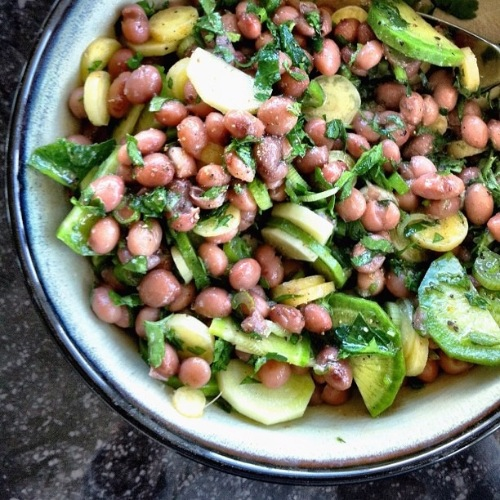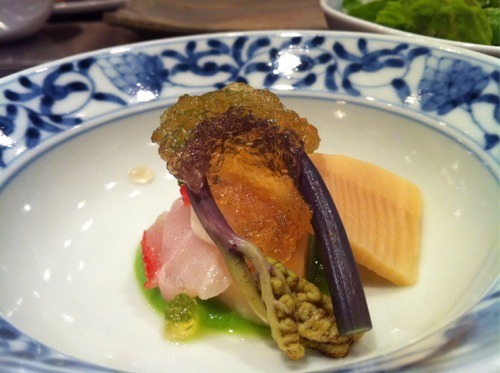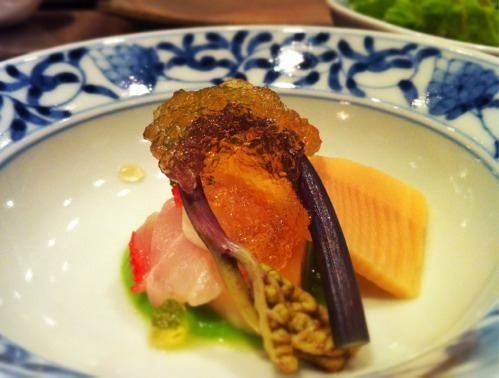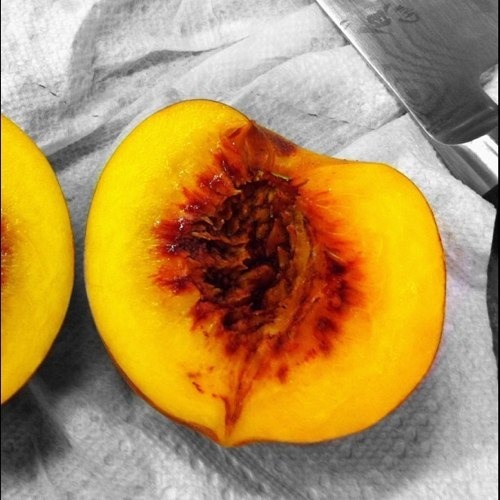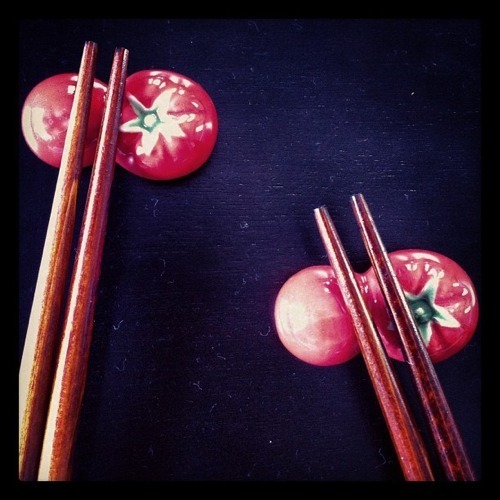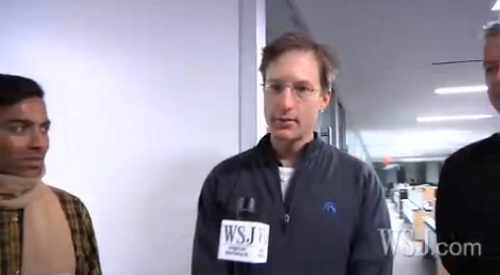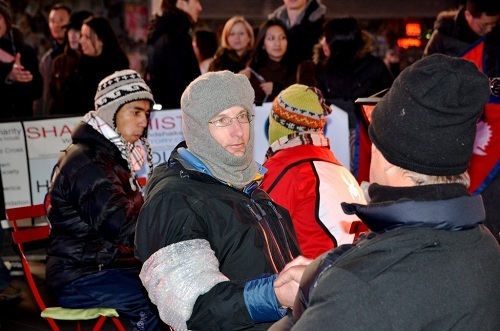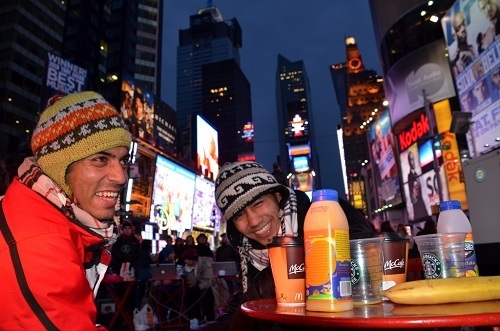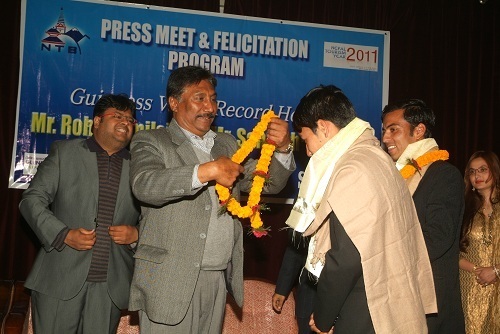Timothy Ferriss's Blog, page 114
December 1, 2012
How to Become a Great (Food) Writer: The Big Secret
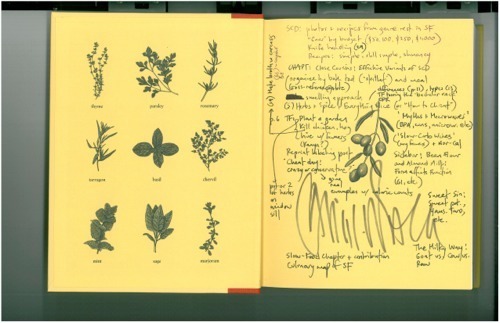
My first handwritten brainstorm for The 4-Hour Chef, here in a signed copy of The Art of Simple Food by the inimitable Alice Waters.
[Quick preface: Have you left an Amazon review for The 4-Hour Chef, if you've read it? It would mean the world to me if you did! Just takes 20 sec here. I'd love to break 500 reviews. Also, for fun, here is my favorite 1-star review  Now, on to the post...]
Now, on to the post...]
—-
“Don’t be intimidated by the red. You’re all good writers.”
I remember Professor John McPhee saying this when he handed back our first weekly writing assignment. We were 12 or so college seniors in “The Literature of Fact,” his once-in-a-blue-moon seminar at Princeton University. The red was Pulitzer Prize-winning McPhee’s edits and deletions.
Each of us looked down in shock. In some cases, his suggestions exceeded our own black text.
Over the subsequent weeks, our writing tightened. Oddly, as the red shrank, as the flowery adjectives and filler disappeared, my grades in every other class shot skyward.
What I learned: writing is the fastest way to improve your thinking. This carry-over is enough reason to put pen to paper, even if you never intend to publish. Just a week or two of writing for friends can work wonders and produce breakthroughs.
The author of the following article is Jeannette Ferrary. I wanted to include this piece in The 4-Hour Chef but, alas, I had to remove more than 250 pages due to space constraints, including gems like this, a nutritional profile of UFC champion GSP, interviews with the incredible Chef Wylie Dufresne, and more.
But you’re in for a treat.
Jeannette is a food writer for The New York Times who has contributed to everything from Bon Appetit to Gastronomica, reviewing restaurants and penning features. She is the author of eight books related to food, including biographies, memoirs, and cookbooks. She also teaches writing courses at Stanford University. Last but not least, Jeannette studied cooking with Simone Beck and Julia Child in Châteauneuf de Grasse, France.
In other words, she knows both food and writing inside and out. Here are her lessons learned…
Enter Jeanette
I like to begin my food writing courses with a quote about eating an apple that makes everyone’s mouth water. It also often generates a nostalgic tear in the eye because, well, read for yourself:
“I know the look of an apple that is roasting and sizzling on a hearth on a winter’s evening, and I know the comfort that comes of eating it hot, along with some sugar and a drench of cream. I know the delicate art and mystery of so cracking hickory-nuts and walnuts on a flatiron with a hammer that the kernels will be delivered whole, and I know how the nuts, taken in conjunction with winter apples, cider and doughnuts, make old people’s tales and old jokes sound fresh and crisp and enchanting…”
The fun begins as people try to guess the words’ author: a culinary memoirist perhaps, one of those journalist-chefs we read only on Wednesdays; the blogger du jour? Whoever it is, one thing is clear: the person knows how to write. So maybe you love food and your great aunt has left a bunch of yellowing recipe cards that you want to transform into a cookbook spiced with family stories and heritage. Or maybe you’re obsessed with those Hatch chiles from New Mexico and you want to expose their specialness and wonders to the wider world. Or your dream is to become the restaurant reviewer for The New York Times.
You might begin by starting a blog of your own, investigating writing assignments in publications you respect, taking a writing course or a cooking class, getting involved with a culinary organization where you can interact with food-world people on a peer level. But there’s something more basic that you have to do: you have to write what you love. What are you interested in? What fascinates you? It’s a good idea to become obsessed with whatever it is so you can happily lose yourself in your subject and maybe drive everyone around you crazy with your enthusiasm. When you’re writing what you care about, it shows. There’s an energy and vibrancy and sensuousness to your work that you can’t fake. It will sound like you and nobody else, which makes it valuable and unique. I know, I know: you want to know how to become a great food writer. So here’s a little story:
On my first trip to France almost 30 years ago, I went to a restaurant in Cannes called Lyonnaise Provençal which offered a four-course meal for eighteen francs, or about four dollars. Because this was my first real meal in France, I allowed myself the splurge of an extra two-and-a-half francs for a quarter liter of wine. The squid arrived in a boat-shaped dish under a dark tomatoey sauce rich with herbs and with something deeper to say, something more profound than a tomato’s usual discourse. Carrot Provençal was just strips of sweet carrot with orange zest and lots of small but important olives. Salade appeared as a simple bunch of leaves with a surprising message: lettuce can have taste. The cheese course was accurately if too audibly described by an unmistakably American guy a few tables away: “The camembert,” he repeatedly informed his dining partner and everyone else in the room, “is dynamite.”
So why should you care? Because here’s the point of all this: Take notes. These events led directly to the publication of the first article of my food writing career. More recently I used specifics such as these in many chapters of my memoir, Out of the Kitchen: Adventures of a Food Writer. If you want to be a writer whose work is lit up and energized by the telling detail and the palpable freshness of the moment, get yourself a nice, little easy-to-carry notebook. And don’t leave home without it.
Oh, and read as much excellent food writing as you can find, like that in the first paragraph. That would be Mark Twain, by the way. In other words, great food writing is…great writing. Simple as that.
[About the Author: For more on and by Jeannette, please visit her site.]
Books/Resources For Writing
TIM: It’s me again. I have a lot of thoughts on writing, perhaps because I find it so damn hard. Here are a few things I’ve loved and learned since 2005.
Bird by Bird: Some Lessons on Writing and Life - If you spend a lot of time working alone, this book is required reading. It has saved my sanity countless times, and it has done the same for several friends who’ve gone from the deadline hell of “I want to quit” to the New York Times bestseller list.
Out of the Kitchen: Adventures of a Food Writer - This memoir, by the author of this post, traces her journey from youthful ambivalence about food (“women’s work”) to food writer for The New York Times. In the process, a number of legendary cooks and personalities make guest appearances, including Simone Beck, Craig Claiborne, Alice Waters, Judy Rodgers, Julia Child, and Jacques Pepin.
The Stanford d. School “Show Don’t Tell” Design Thinking Bootcamp - How do you create the most powerful story arc, whether written or visual? These fascinating (and free) presentations will kick your creativity into high gear for unique and compelling story structure.
Professor Jennifer Aaker’s “How to Tell a Story” Class - At the very least, try the six-word story exercise. Hemingway made it famous with what he called his best work: “For sale: baby shoes, never worn.” Hat tip to Avi Solomon for pointing me to this.
Writing Online And For Magazines
From First TV to Dr. Oz: How to Get Local and National Media - This post includes the actual query (pitch) I emailed to Wired Magazine that landed a 4-page-plus feature piece.
How to Build a High-Traffic Blog Without Killing Yourself - This article explains how I went from 1 blog reader (Thanks, mom!) to more than 1,000,000 monthly readers by doing the unconventional (e.g., posting once every 3-4 weeks instead of daily). In the accompanying keynote from the annual WordCamp conference, and using my own blog as a case study, I explain best practices, debunk blogging myths, and cover how to harness data for better results. For the record, I suggest first-time bloggers use WordPress.com as a blogging platform. It’s the most Google-friendly (search rankings) out-of-the-box, and I’ve found it easiest to use.
David Lebovitz - Food blogging tips from David Lebovitz, former pastry chef at Chez Panisse and author of six books.
Food Blog Alliance - How-to examples for food bloggers (recipe attribution, shooting food videos, etc.).
Selling Books, Hitting Bestseller Lists
12 Lessons Learned Marketing The 4-Hour Body - This is a step-by-step explanation of everything behind the launch of The 4-Hour Body, which ended up hitting #1 New York Times and outselling The 4-Hour Workweek 5-to-1. If you’re curious about what it takes to keep a book on the bestseller lists for more than four years unbroken, this will give you a rare behind-the-scenes picture. As of this writing, I’m also the only author besides Suzanne Collins (Hunger Games) to have two books in the top-10 of the Kindle “most-highlighted books of all-time.”
Publishers Lunch - The publishing industry’s daily email digest of deals. Learn about books up to a year before they hit the shelves: what sold to which publishers, which agents sold them, and how big the advances were. If you’re hoping to sell a book (non-fiction is best sold before it’s written), this is where to find agents who rep your genre of book, and to discover who is good at creating bidding wars for the big bucks.
Good Food Writing – Exemplars
By no means an exhaustive list, here are a few short stories and books that have inspired me. Each represents a different genre. Consider them a starting point:
Brigade de Cuisine is a New Yorker short story and profile by John McPhee. If you want a taste of why McPhee’s writing makes me cry into a pillow about my own, try this or Coming into the Country.
Heat: An Amateur Cook in a Professional Kitchen is a narrative autobiography by Bill Buford. I quote this book like mad. It’s absolutely hysterical and one of my all-time favorites. The style is reminiscent of George Plimpton, another of my idols.
How to Cook a Wolf is a Depression-era autobiography with interspersed recipes, both by M.F.K. Fisher. Yes, I’ve now recommended this book twice. Go get it.
Like Water for Chocolate (Como Agua Para Chocolate) is award-winning fiction by Laura Esquivel. If you like this and want more foodie fiction, try Mistress of Spices next.
Best Food Writing 2005, 2006, etc. This is an annual anthology of good food writing compiled by Holly Hughes, who pulls from newspapers, books, magazines, blogs, and more. Contributors range from Ruth Reichl and Anthony Bourdain to Jonathan Safran Foer and J. Kenji Lopez-Alt. There’s something for everyone and the pieces are, ahem, bite-sized for easy consumption.






November 30, 2012
The 4-Hour Chef is a NYT, WSJ, and USA Today Bestseller! But There is Mystery and Intrigue…
Thanks to all of you, The 4-Hour Chef will now be featured on all of the big bestseller lists: The New York Times (available to the public shortly), The Wall Street Journal, USA Today, and Publishers Weekly.
THANK YOU!!!
I’m honored to have the opportunity to write for you, and it’s been an amazing trip. It always is. I’ve known some of you since 2007! Seems like a lifetime ago, and I hope to be alongside you for decades to come. Your reviews are what keep me going during the most stressful times.
On that note, let’s look at the week in review: this launch was very different and very challenging. I couldn’t have done it without you, the tremendous online and offline support, including Hastings and the indies backing this book. Without B&N at the party, my team and I had to innovate and experiment to even scratch the lists. Unorthodox bookselling avenues were created (Panera, BitTorrent, etc.) and many new things were learned.
For instance, BitTorrent conversion is NUTS. Of 210,000 downloads (of this bundle) earlier this week, more than 85,000 clicked through “Support the Author” to the book’s Amazon page. We all had to triple and quadruple check that to believe it. Even at a 1% conversion after clicking an effective “buy now” link, that translates to 850 books… and BitTorrent is only accelerating. Wow.
I also came to understand the hard costs of producing The 4-Hour Chef.
This book, a full-color 672-pages at $21-35 end-user pricing, would have been impossible or nearly impossible to produce outside of Amazon Publishing. Marketing and merchandising muscle aside, I owe them tremendous thanks for the most important element of all: paying for exactly what I wanted my readers to have. In the end, product is king. Marketing might get you on the list for a week, but only good content will keep you selling for years. They allowed me to showcase the best of what I had to offer.
To that point: I’m in this for the long-haul, and my goal is never to be a “one-week wonder” on the lists.
I have zero interest in approaching pub date like opening weekend for a big movie. Both of my previous books are still going strong, and my proudest accolade is perhaps the least known. Here it is: there are only two authors (excluding the author/authors of The Bible) who currently have two books in Amazon’s “Most Highlighted Books of All Time” top-10 list: Suzanne Collins of The Hunger Games and me. Crazy but true. Many, many months ago, The 4-Hour Body was #1 for months.
I would love to add The 4-Hour Chef to that top-10 list. That list, which reflects readers’ feeling after buying, is much more important to me than the bestseller lists, which can be gamed. I know exactly how the black-hat folks do it, and I choose not to participate.
Regardless, and much to the chagrin of my critics, I’m just getting warmed up.
This leads us to…
Those bestseller lists — what happened exactly?
For the vast majority of you, the following will be boring. In fact, it’s pretty boring to me, but I need to understand the minutiae. If you’re an author, I’d highly suggest that you get familiar with the lists. They can be fickle and (sometimes) seemingly irrational beasts.
First, here is my previous primer on the basics of the bigger lists.
Next, before we delve into details, a fundamental piece of advice: start-up-style iteration isn’t just for product. It’s also for distribution.
I did NOT pull all my eggs into this first week, precisely because I wanted to iterate distribution. Since I am being boycotted by Barnes & Noble and others, it was unclear which of my sales would be counted or discounted by BookScan and others. I therefore reserved a lot of powder in the keg for later use, once lessons were learned.
It was a good thing I did.
See, I’m as obsessive about book data as I am about tracking physical data. In a single ongoing spreadsheet, I have weekly sales for every channel and every outlet for all of my books since April, 2007.
A few basic observations:
• BookScan only represents 25-30% of the market for most major bestsellers, but its rankings are relatively true, making it a good measure to sort out the variations in the NYT.
• USA Today is the only list that mixes ALL formats, including but not limited to eBooks.
• The NYT Advice list is the only major nonfiction list that doesn’t track eBooks for “Advice, How-to, & Misc.” This means all how-to books and cookbooks are omitted, among others.
• On the main NYT “nonfiction” print list (not “Advice, How-to, Misc.”), O’Reilly was listed as #2 and the #1 book sold half of what he did on BookScan.
• On the ALL formats USA Today list, the #1, #2 and #3 NYT books were at #24, #70 and #35 respectively, all below The 4-Hour Chef‘s #13 ranking.
Pretty odd arithmetic all around, huh? This leads to…
A few observations and questions to the universe:
- Isn’t it odd that 4HC was the #1 non-fiction book sold on Kindle last week, and the #1 ebook on The Wall Street Journal list, but it doesn’t even show up on the NYT ebook bestseller list? Why would that be?
- If the NYT list doesn’t reflect what people are actually reading, what does it reflect? Will they adapt to the times (and full spectrum of non-fiction) or be replaced? I would wager they have a matter of months to decide.
- The NYT does not appear to accept Kindle sales for my book, as it’s from a “single vendor.” That’s really too bad, since Amazon is the largest seller of ebooks in the world. It should be noted that Amazon offered The 4-Hour Chef to Barnes & Noble for their Nook device, and they declined.
- The 4-Hour Chef sold more than 60,000 copies in print and ebook its first week, which would likely put it at #1 on the NYT combined list if its ebook sales were counted. The media is overlooking this print-to-digital mix change and hanging on to the outdated notion that bestseller status = solely print retail sales. I sold more than twice Bill O’Reilly, who had an estimated less than 10k eBooks and was #1 on the NYT eBook list.
- Amazon sold more Kindle copies than print copies of The 4-Hour Chef. My first-adopter demographic is made up of readers who are embracing digital and driving digital growth, so this is not only relevant, but also strategic. We know, for instance, that week-one ebook sales of 4HC were more than week one ebook sales of The 4-Hour Body (over a 30% increase from my last launch, using the 21,000 number on hand), which given my audience–and it could very much be argued the future of book publishing–is a trend in the right direction.
###
None of this is sour grapes.
If I were in this for one week, it might be, but I have big bombs held in reserve, all to be used soon enough. I want The 4-Hour Chef to become a movement, and that will take years to reach full potential, not weeks.
I’m in no rush.
This is a ready, fire, aim-type of game. There is a lot more to come, so keep watching. If B&N would like to join the party, I’ll have a glass of wine waiting. Either way, it’s going to be one hell of a party.
Onward unto the breach!






November 24, 2012
The 4-Hour Chef Launch — Marketing/PR Summary of Week One
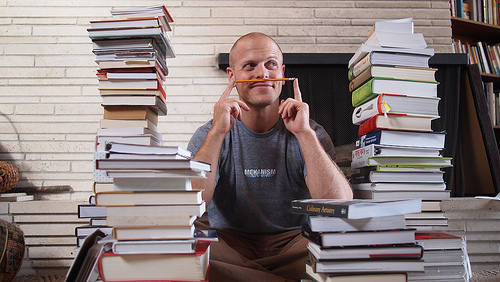
What a whirlwind of a week!
For those of you interested in how I sequence launches, or how punishing the last 7 days have been, or what’s required if you want a shot at #1 New York Times or BookScan, below is a very partial list of media coverage and partnerships. They are in rough chronological order. If I missed anyone, please let me know in the comments!
I’ve done more here than in my last two book launches combined, and reader results (Twitter examples here) have made it all worth it.
I was pleasantly surprised by how many bookstores are now stocking The 4-Hour Chef, which sat at Amazon #2 for most of this week (Diary of a Wimpy Kid is a juggernaut, but Ina Garten is my real competition). According to my readers on Facebook, stocking stores now include Tattered Cover, Copperfields, Powell’s, Elliot Bay, Vroman’s, Prairie Lights, Changing Hands, Boulder Bookstore, and even some Books Inc. (my local fave). Barnes & Noble continues to boycott nationwide, but indies are picking it up, which makes me very happy, of course. It’s exactly where I want a 600+-page full-color book!
Last but not least, sincere thanks to everyone who’s left Amazon reviews!
If you have read the book (or are reading), pretty please take 30 seconds to leave a short review — it would really mean the world to me. Just click here. I have read every review and commented on many of them. At the very least, if you take a look here, there are some great conspiracy theories in the 1-star reviews. Many folks don’t seem to grasp the idea of ADVANCED copies of books, which all authors send out, often in the hundreds. Doing the same doesn’t make me a Scooby-Doo villain or clever mastermind, alas.
Now, to an incomplete list of media from the past 168 hours or so, excluding national advertising…
Offline/traditional names
USA Today – ’4-Hour’ author Timothy Ferriss returns as a chef
The New York Times - Fête Accompli | 4-Hour Feasting
The Wall Street Journal - ’4-Hour’ Man Masters Food, The Good Life
Bon Appetit - A Bird in the Pan: Testing “The 4-Hour Chef”
Outside Magazine – From Modern to Mallman (one of three online, also a print piece)
Wired Magazine – “Better, Faster, Smarter” (Tim Ferriss tests smart drugs) — not yet online but in Dec print.
CBS This Morning (Charlie Rose, Gayle King) – Timothy Ferriss talks food, life lessons
Fox & Friends – ‘Recipe’ for Success
The New York Post – Required Reading
Dr. Oz (almost an hour total on TV, plus online) – Health-boosting Secrets From The 4-Hour Chef Tim Ferriss
Dr. Oz – Tim Ferriss’ Plan to Master Cooking in 4 Hours, Pt 1
Dr. Oz – Tim Ferriss’ Plan to Master Cooking in 4 Hours, Pt 2
Dr. Oz – Tim Ferriss’ Vitamin-Rich Recipes
Partnerships
BitTorrent (160 million+ users — more coming on this)
Panera Bread (1,500+ locations)
TaskRabbit (1,000s of hours saved)
Rally (1,000+ books sold)
Blogs/online press
PaidContent – Ferriss: Even if I sell a million Kindle books, some people will call it a failure
PaleoHacks – If you could become world-class in anything in 2013, what would it be?
BoingBoing – Tim Ferriss’s new book about learning
The Huffington Post – New Timothy Ferriss Book, ’4-Hour Chef’, Has A Great Trailer (VIDEO)
Small Business Trends – Retailers Fight Amazon with Ferriss Boycott
Seeking Alpha – Amazon Is Crushing It
Digital Journal – Review: ‘The 4-Hour Chef’ is more than just a cookbook
TechCrunch – With Amazon Publishing Stonewalled By Retailers, Tim Ferriss Taps BitTorrent To Market His New Book (and more press here)
The Huffington Post – “4-Hour Chef” Tim Ferriss Reveals Secrets of Meta-Learning and Living the Good Life
Ramit Sethi - Live webcast w/ Tim Ferriss this Wednesday, 9PM EST
Danny Roddy – My Interview With Bad Ass Mother Fucker Tim Ferriss
Livestrong – Make Better Meals In Less Time
TubeFilter – With Help Of YouTube, Tim Ferriss Makes Book Trailers Go Viral
Metro – The art of learning
Goins Writer – How to Become World-class at Anything: An Interview with Tim Ferriss
Entrepreneurs-Journey – Tim Ferriss Talks About His Latest Book “The 4-Hour Chef”, How To Learn Anything In Half The Time And Why He Went To Sniper School
99U – Tim Ferriss: On The Creative Process And Getting Your Work Noticed
The Art of Manliness – How to Make the Best Beef Jerky in the World
Cooking for Engineers – Crunchy Bloody Mary
InsideHook – Culinary Design
Man Vs. Debt – Rapidly Learn Any Skill (Including Cooking): An Interview with Tim Ferriss about “The 4-Hour Chef”
Greatist – The 4-Hour Chef: Tim Ferriss’ Crazy, Brilliant Cookbook
Personal Branding Blog – Personal Branding Interview: Tim Ferriss on The 4-Hour Chef
5 Minutes for Mom – An Interview with Tim Ferriss- Author of The 4-Hour Chef
Slashfilm – Author Tim Ferriss Lists His Favorite Cooking TV Shows and Movies
AskMen – Tim Ferriss On The 4-Hour Chef
Chronicles of Strength – How to Learn Anything: Pat Flynn Interviews Tim Ferriss on The 4-Hour Chef
Runkeeper – We’re giving away 20 copies of Tim Ferriss’s new book!
Lifehacker – I’m Tim Ferriss, and This Is How I Work
Shira Lazar: What’s Trending – How to Complete All Your Facebook Tasks in Just 4 Hours: A Tim Ferriss Presentation
Gothamist – After Thanksgiving, Go On A Manhattan Food Marathon
Refinery29 – How To Get Into Every Resto In Town, A Primer By Tim Ferriss
The Grindstone – Tim Ferriss Will Teach You How To Cook In 4 Hours And Conquer The World
Food Babe – The 4-Hour Chef – The Coolest Cookbook I’ve Ever Read
KrisKris – The 4-Hour Chef – Interview With Bestselling Author Tim Ferriss
Wellness Mama – How to Cook Like A Pro and Learn Anything
BoingBoing – Timothy Ferriss: Cheat Sheets for Everything
Cracked – 8 Cheap Ways to Fake Being a Pro Chef
The Huffington Post – The Anti-Hunter’s First Hunt (Exclusive Excerpt)
Gear Patrol – Interview: Tim Ferriss on Steak, Kitchen Tools and the Return of the Polymath
AskMen - The 4-Hour Chef: Exclusive Look: Tim Ferriss’ New Book
Wall Street Cheat Sheet – Tim Ferriss: The 4-Hour Chef Controversy Displays the Future of Publishing
Social Triggers – The simple path to becoming a highly-paid expert (new podcast with Tim Ferriss)
AllFacebook – Humor: How To Complete All Of Your Daily Facebook Tasks In Just Four Hours
Business Insider – The 4-Step Process For Mastering Any Skill
Lifehacker – Use Tim Ferriss’ Four-Step Process to Master New Skills
Cook Taste Eat – Pork Loin with Walnut Purée, Poached Carrots and Bacon Frisée Salad
Podcasts/video/YouTube
Andrew Zimmern: Go Fork Yourself Podcast – Go Fork Yourself: Tim Ferriss & The Four-Hour Chef
creativeLIVE – The 4-Hour™ Life: Healthy, Wealthy and Wise
The Joe Rogan Experience – JRE #285 – Tim Ferriss, Brian Redban
Firepole Marketing - 4-Hour Book Launch Advice from Tim Ferriss
Shira Lazar: What’s Trending – “4-Hour Chef” Tim Ferriss Reveals Secrets Of Meta-Learning And Living The Good Life
Samovar Tea – Samovar Tea Talks with Tim Ferriss
Mixergy – Tim’s Rapid Learning Method And The Four-Hour Chef – with Tim Ferriss
The Art of Charm: Pickup Podcast – Episode #178: Tim Ferriss, FourHourChef.com (FourHourWorkWeek.com)
The New Man Podcast – TNM 125: Tim Ferriss – How to Be Kickass Fast
SiteVisibility – Tim Ferriss – Podcast Episode #189
SourceFed – Greatest Day Ever: a Guide
SimplePickup – How To Make a Sexy Steak with Tim Ferriss
Sources of Insight – Tim Ferriss Interview on The 4-Hour Chef
The Rise to the Top – Tim Ferriss on How to Become World Class in Anything in 6 Months or Less
Radio-TV Interview Report – Steve Harrison Interviews Bestselling Author Tim Ferriss About Book Writing, Promotion and Ways to Learn Any Skill Faster
Alex Day – Unrealistic Goals and Tim Ferriss
New Media Rockstars – Author & Internet Entrepreneur Tim Ferriss Talks to NMR About His New Book The 4-Hour Chef and More! [Interview]
Zen Habits – How to Learn Anything
Big Think – Tim Ferriss: Cooking to Learn Like a Pro (in 4 Hours)
Wall Street Cheat Sheet – Tim Ferris: The 4-Hour Chef Controversy Displays the Future of Publishing
Six Pixels of Separation – SPOS #333 – Learn To Do Anything With Tim Ferriss
Evernote Blog
Yelp! Blog






November 23, 2012
Food Photography Made Easy — Simple Tricks and Pro Tips from The 4-Hour Chef
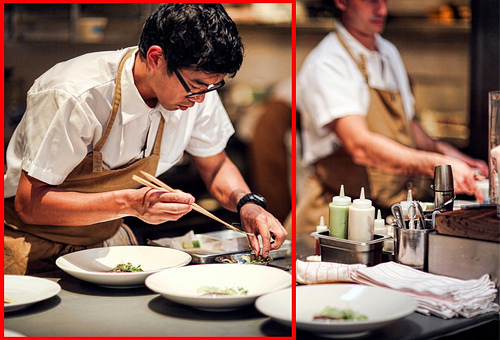
A great pic from Christopher Michel of Central Kitchen in San Francisco. The red box indicates how we cropped for pg. 15 of The 4-Hour Chef.
Christopher Michel has taken pictures from outer space. OK, technically, it was aboard a U-2 “Dragon Lady” spy plane at the edge of space. But still.
Best known as founder of Affinity Labs, Chris has one of the most unbelievable bios I’ve ever seen. Between serving on the board of the U.S. Naval Institute and acting as an Entrepreneur-in-Residence at Harvard Business School, he’s managed to publish four fine art books full of his photographs. He’s the one responsible for getting me interested in photography. After taking my pic with his favorite M9 and Leica Noctilux (50mm, f/.95 lens), and after seeing me marvel at the quality, he insisted I get a proper camera to chronicle my adventures and misadventures.
But what camera to get? And what about lenses and all the other accessories? “50mm” meant nothing to me, nor did “f/.95.” The jargon is enough to make your head spin.
Based on my scattered research, it seemed that I needed an expensive Frankenstein’s monster of high-grade gear. Thankfully, before I could max out my AMEX, Chris suggested a smaller and less expensive combination: the Olympus PEN E-PL2 micro four thirds camera (body) and Panasonic Lumix G 20mm f/1.7 Aspherical Pancake Lens. It was this precise suggestion that took me from my long-standing “I should really get into photography” to actual shooting.
The gear was no longer my bottleneck.
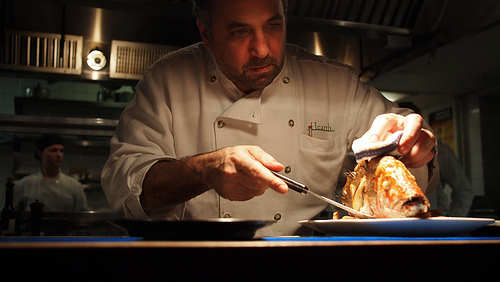
Chef Marco Canora serving up red snapper at the wonderful Hearth in NYC. We drank almost five bottles of wine that night.
And this combo! It turned out perfect for close-up food photography, even in very low-light conditions. It was simplicity itself to turn A below (iPhone) into B (exact same shot with Olympus/Lumix):
A – Parmesan and white chocolate macaron at Saison, complete with gold leaf. Taken with the iPhone.
B – Same shot… but much more beautiful. Taken with an Olympus PEN E-PL2 and Panasonic Lumix pancake lens.
Roughly 20% of the 1,000+ photos in The 4-Hour Chef were taken by me using the aforementioned gear. No Photoshop, no zoom, nothing fancy; just a nice lens and improved composition thanks to Understanding Exposure by Bryan Peterson, which is required reading.
That’s more than enough to get started and kick ass. The above is all I used for six months.
But there’s more fun to be had, naturally. Let’s look at the iPhone and the big guns, each in turn, as you can blend the best of both worlds…
There’s An App For That
What if you don’t want to lug a “real” camera to every meal? Np, as the youngsters say. The pros get sick of feeling like pack mules, too.
The following iPhone recommendations are from Darya Pino, a Neuroscience PhD and well-known food blogger at SummerTomato, one of Time’s 50 Best Blogs of 2011. Her posts feature photos taken with both professional gear (including full lighting set-up and tripod) and her iPhone. Some of the latter are jaw-droppingly stunning, which was always puzzling, as I couldn’t replicate any of it.
No longer. When Darya leaves the backpack at home, here are the apps she uses to level the playing field:
“This is, by far, my fave. It’s simple to use and all the functions work amazingly well. For quick editing, I use ‘tune image’ for the kind of adjustments you’d make in Photoshop: levels, brightness, contrast, saturation, white balance, tilt shift, etc. I like to up the saturation a bit to brighten the greens, etc., especially in low light. Tilt shift is similar to depth of field, making the focal point more focused and the rest blurrier.
This is the minimum I do for most photos I post online. If you need a little more functionality, Photogenie is also a great editor.”
Snapseed Only
Snapseed With Tilt Shift – Fish On Sticks
“This is essential for taking the photos before you edit them. It really helps for food photography. The biggest issue with food is that it is wet. Plus, it’s often served in low lighting. In restaurants, this makes dishes look brown and disgusting, especially if you compound the problem with flash.
You won’t need it every time, but in weird lighting or situations where you want a lot of detail, it can’t be beat. It also has some basic editing capability, but I usually move to Snapseed instead. Camera+ also takes nice pics and has some interesting filters, but it has too many functions for my taste and feels heavy. Kevin [Kevin Rose, her fiancee and renowned tech influencer] likes it a lot, though.”
ProHDR Only
ProHDR + Snapseed: After ProHDR, Darya used Snapseed to up the “ambiance,” improve the white balance and saturation, straighten the image, add a tilt shift effect, and crop it slightly.
“This is also worth purchasing, in my opinion. It only has one function, but it does it really well. Basically, it lets you turn a photo black and white, then selectively return the color to anywhere in the photo by rubbing your fingertip on it. It creates an awesome effect when used well.”
ColorSplash, With Fruit
“I use Instagram as a social app, rather than for editing. I use the above apps to shoot and edit, then I share the images via Instagram. One awesome thing about this app is that the web links (these appear when you Tweet your pic) take people to nice big, high-res pics that work for almost any blog.”
Photo from Instagram
The Pro’s
But what it you want to take it up a notch? That’s when I pose questions to award-winning photographer Penny de los Santos, who’s shot for Saveur, National Geographic, Sports Illustrated, and Time, among others.
Are there any real rules for shooting food?
People have all these rules about shooting food. Here are a few I’ve heard repeated by young photographers during workshops I’ve led:
• Avoid photographing food on purple surfaces or purple linens.
• When photographing spaghetti, tuck in all the ends of the noodles.
• Always use a tripod.
Throw those out the window. Whatever it is people say you shouldn’t do, ignore it. I shoot a ton without a tripod and I always laugh when people say it’s the most important thing.
The big secret is to buy the best ingredients you can. Go to the farmer’s market, not the grocery store, the morning of the shoot. Don’t buy one bunch of beets, buy 3 or 4. Buy the produce that looks the best. It’s not about how it tastes.
If you’re shooting meat or vegetables that have been cooked, it’s always nice to brush them up with a little bit of olive oil before you shoot it to make it come alive and give it some shine.
What are some of the biggest mistakes that novices make?
The first mistake a lot of amateurs make is they shoot with their camera’s built-in flash.
The second is they stay in one position, where the food lands right before they eat it. It’s important to look at food from every angle, not only adjusting your proximity to the plate, but also adjusting the food so that you see it the best.
The third is that most people shoot food way too close. They want to see the drips coming off the meat. Instead, pull back and give your subject some space.
Is there any equipment you can’t live without?
You don’t need to have a deep camera bag. You can do it with just one lens.
Once you have an iPhone 4s or better, you can choose depending on your budget:
Bodies:
Canon G15 (about $500) or Lumix GF3 ($279). These are both great small cameras that shoot RAW, have HD video, and are excellent for food.
Canon 5D Mark III ($3500 body) or Canon 5D Mark II ($2500 body): Top of the line, professional-quality gear. The latter is the former’s still-great predecessor.
Lenses:
I use Canon’s 24–105mm f/4L a lot (about $1,000)
Props:
Props are essential for bringing your photographs to life. Go to thrift stores and garage sales and find old vintage plates and weathered boards and start a prop closet. Collect forks and knives and bowls that have a lot of character, and then use those as a vessel for your food. If you can’t spend the time searching, Etsy.com and eBay are great for propping. If you have a budget and live in a big city, you can rent from prop houses. Or go check out a prop house to scout what they have, then set out to get your own.
If someone wants to teach themselves how to be a great food photographer, how do they start?
It’s important to learn the basics of photography first. Then, don’t miss opportunities to train your eye. Look at the food magazines—I like Donna Hay and Saveur. Study photographers, not just self-described “food photographers.” I’ve been inspired by four masters in seeing, finding moments, and harnessing beautiful light: Sebastian Salgado, Henri Cartier-Bresson, Irving Penn, and Martin Parr. The last two see the potential in food and have a strong voice about it.
Take a food photography workshop to understand what it means to shoot food and how to approach food. Then challenge yourself. Give yourself five recipes one day, make the dishes, and really think about how you’re going to photograph each one.
###
Everybody has to eat, so why not shoot what you’re eating?
Be playful. Food photography isn’t just one glamour shot before your stuff your face. Take a few shots before you eat, a few more once it’s half eaten, and capture the mess at the end with the wadded up napkin. Perhaps that tells a better story?
And stories are what create better memories for you… and evoke stronger emotions from viewers. Have fun with it.
###
Related food pics and coverage — The 4-Hour Chef launch dinner:
- The New York Times – Fête Accompli | 4-Hour Feasting
- The Wall Street Journal – ’4-Hour’ Man Masters Food, The Good Life






November 21, 2012
What to Do If Boycotted by 1,000+ Bookstores? Open Your Own Bookstores, Of Course.
So far, The 4-Hour Chef has had some great allies, including Panera (complete with new hidden Slow-Carb Diet menu), BitTorrent (bundle here), and Hastings. In San Francisco, Samovar Tea Lounges in now selling signed copies in all locations!
But I’m most excited about my next partner: you.
What to do if 1,000+ books stores are boycotting you? Create your own bookstores, of course. That’s where The Army of Davids Campaign comes in.
- From now until Friday at midnight PST, interested readers can sell The 4-Hour Chef through their own “bookstore” Fan Fundraising pages on Rally.org here.
- I will donate $6 of every book sold (100% of my royalties and then some) to DonorsChoose.org to help high-need public school classrooms.
THE PRIZES
#1 – Grand Prize for most books sold (500 books minimum): An all-expenses-paid overseas food sabbatical with me and friends. You’ve seen me host trips to India, Africa, and elsewhere. They’re always a blast. Though details are TBD and dates will be mutually agreed, it’s likely we’ll be doing a high-end trip through Tuscany, Italy.
#2 and #3 – Runners-up Prize for second and third most books sold (250 books minimum): An all-expenses-paid full-day trip to SF to see my favorite spots and enjoy mastermind jam sessions with me and a small group of entrepreneurs.
Find full details here, and I hope to travel with you soon! If you need an inspirational video to get you pumped, here’s one of my favorites. Avante!






November 20, 2012
Meet The New York City Food Marathon: 26.2 Dishes in 26 Locations in 24 Hours
Excess can sometimes be delicious.
Thanksgiving is a great example. The NYC Food Marathon, however, takes things to an entirely new level. Think of it as a 24-hour Thanksgiving on steroids: 26.2 iconic dishes in 26 locations, all hit by foot in 24 hours.
It’s one of the most insanely fun ways to spend a Saturday.
Which restaurants (and dishes) would you pick for a food marathon in your own city? Please let us know in the comments. Here are the ones we picked in NYC with the help of top chefs…
[The following is excerpted from The 4-Hour Chef.]






The 4-Hour Chef is LIVE — Dr. Oz, NYC Cabs, TaskRabbit, London, and More

The 4-Hour Chef has arrived and is available today.
It’s 672 pages of full-color goodness that required blood, sweat, and tears (literally) for nearly two years. Putting it together was brutal. In the end, I think it’s the best book I’ve written, a very unusual choose-your-own-adventure guide to learning and life. I really hope you like it.
This week is a big ‘un. To get us started…
- I will be on Dr. Oz today for 30+ minutes. Full of surprises. Find local times at the bottom-right corner here.
- All NYC cabs will soon be running a 15-second version of The 4-Hour Chef cinematic trailer. I thought it’d be fun to carpet bomb the city. Why not? The trailer has nearly 1.5 million views and is now the most-viewed non-fiction book trailer of all-time.
- I’ve partnered with TaskRabbit to automate grocery shopping nationwide. For all recipes in the first DOMESTIC section, you can order ingredients for each “lesson” with one click. Click here to see if it’s available in your city.
- Come hang out with me in NYC today! From 3pm-6pm ET, I’ll be signing books (my only NYC book signing!) at Panera Bread at 452 5th Avenue (at 39th). Hope to see you there.
- If you haven’t yet, please consider buying the book as a X-mas/holiday gift! The more, the merrier! It’s truly a gorgeous book…easily the most beautiful thing I’ve ever made. The 4-Hour Chef was #2 on Amazon earlier, but it’s currently getting blasted by an unexpected onslaught of Disney Nursery Rhymes. Merciless!
- The UK edition of The 4-Hour Chef also launches today. I’ve always wanted a simultaneous US/UK launch. Now my friends across the pond don’t have to wait for “pants” to become “trousers”! I’ll be visiting London in January to party with y’all. Stay tuned.
In the meanwhile, I’ll be following Chef Thomas Keller’s instructions…
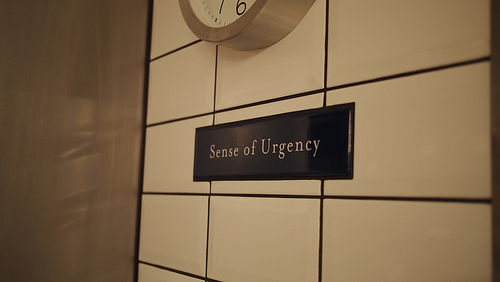
The kitchen of Thomas Keller’s Per Se in New York City. It is only one of seven restaurants in the US to be awarded three Michelin stars. (Photo from The 4-Hour Chef)






November 19, 2012
The 4-Hour Chef is Available 24 Hours Early… in Panera Bread?!?
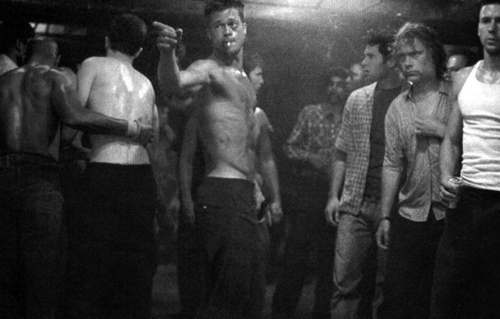
Barnes & Noble is boycotting The 4-Hour Chef in its 723 or so retail locations nationwide.
That makes me cry a little, but… Panera Bread has nearly 1,500 bakery-cafes in the US. Starting today, Monday, November 19th, I’m running an experiment with my good friends at Panera.
24 hours before the official pub date of The 4-Hour Chef, you can get an advanced copy at one of Panera’s four downtown Manhattan locations. Books will be on-sale from 10am-6pm EST. Not only that, but you can now order 4-Hour Chef-approved Slow-Carb Diet® dishes in the same locations. Just tell them you’re ordering from the “hidden menu”.
Pay ‘em a visit and check out the new set-up — it’s all a hint of things to come:
86th and Lexington Ave.
29th St. and 7th Ave.
10 Union Sq. East
39th St. and 5th Ave
For the official pub date — Tuesday, 11/20 — I’ll be signing and selling copies of The 4-Hour Chef at the 5th Avenue location from 3pm-6pm. I’d love to see you and say hello in person!
Big things are afoot. Plans are being schemed. Old models shall be stress-tested.
A teaser: If you order the hardcover of The 4-Hour Chef by 11:59pm PST tonight, you will get a $5 Amazon Gift Card automatically. Then, the Kindle edition of The 4-Hour Chef will mysteriously drop from $9.99 to $4.99 at midnight (11/19) and remain that price until midnight 11/26. This means: If you order the full-color hardcover of The 4-Hour Chef (the optimal reading experience, IMHO) before midnight tonight, you can get the Kindle edition for free! Details here.
And not to worry: If you already ordered the hardcover, you’ll still get the $5 gift card. If you ordered the Kindle edition at a higher price, you’ll only be charged the $4.99. Winning.
Much, much more to come. BitTorrent and Panera partnerships are just the beginning.
Kia kaha,
Tim
###
If you missed the samples from every section, here they are again:
Front Matter: (PDF, blog post)
Introduction: (PDF, blog post)
Meta-Learning: (PDF, blog post)
The Domestic: (PDF, blog post)
The Wild: (PDF, blog post)
The Scientist: (PDF, blog post)
The Professional: (PDF, blog post)
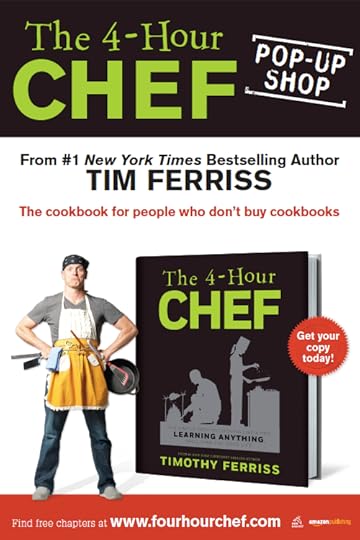






November 17, 2012
The 4-Hour Chef – Samples from All Sections (Plus: $5 Amazon Gift Cards)
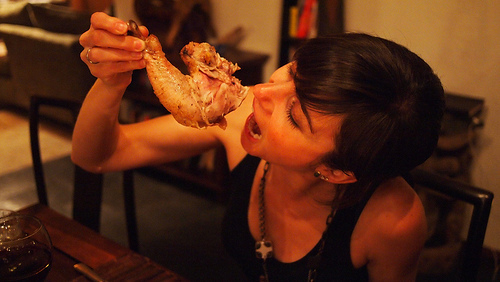
Thanksgiving 2011–Darya Pino of Summer Tomato, chowing down at my house. Food = Love.
I can’t wait for launch! Less than 48 hours away…
To whet your appetite, here are sample pages from every section of The 4-Hour Chef. The PDFs are far prettier (and from the book), but the blog posts may load faster:
Front Matter: (PDF, blog post)
Introduction: (PDF, blog post)
Meta-Learning: (PDF, blog post)
The Domestic: (PDF, blog post)
The Wild: (PDF, blog post)
The Scientist: (PDF, blog post)
The Professional: (PDF, blog post)
There is also a soundtrack (yes, a soundtrack) for The 4-Hour Chef. Here are the 29 songs.
Want a $5 Amazon Gift Card?
Good news: if you already bought a print copy of The 4-Hour Chef, you’ll be getting a $5 Amazon Gift Card! This brings the effective cost from $21 down to $16. That’s more than 50% off the $35 cover price!
Until tomorrow (Monday, November 19th) at 11:59 p.m. PST, Amazon is offering a $5 gift card to anyone who orders the hardcover edition of The 4-Hour Chef. Find all the details, fine print, and naked pictures of me here. Just kidding on the naked pics.
What else might Amazon be up to this week? Hmmm… How about full-page ads in People Magazine and bus wraps in NYC? That’s just the tip of the iceberg…
Second Printing and Errata
“Errata” is a fancy way of saying corrections in a book or article. The 4-Hour Chef is going into a second printing, and here are a few screw-ups we caught and are fixing:
SCI
p. 472: Tanya Harding should be Tonya Harding
PRO
p. 500 (2nd to last line): eying should be eyeing
p. 505
Under Technology, (left-hand column, second line from the bottom), the sentence should read “It has a surface that can be lowered to -30ºF.” Currently it reads “45ºF.
APX:
p. 573: Correct spelling of Liechtenstein in the shorthand recipes.
p. 606: In the quote attribution at the top of the page, correct the spelling of Rain Man–should be two words.
###
Tonya Harding AND Rain Man in a cookbook? Oh, yes. Not to mention Calvin & Hobbes and Alessandra Ambrosio, too…






November 16, 2012
The Magic of Thinking Big – How to Break World Records in Times Square
Preface from Tim
The following is a guest post by John-Clark Levin, Joe Luchsinger, and Jason Soll.
I’ve been waiting for the perfect time to publish it, and today is that day. Why? I have big battles coming next week, and they make me want to tackle the world.
By the time you finish reading this post, you’ll learn how they:
• Booked the heart of Times Square for three days for only $20
• Brought together teams of elite competitors from as far away as Nepal and New Zealand
• Organized a record-breaking competition as full-time college students…from 3,000 miles away
• Received a promotion on every page of YouTube.com, ultimately receiving over 800,000 webcast views and tens of thousands of comments during the course of the event
• Landed extensive coverage by the Wall Street Journal, ABC, NBC, CBS, and AOL News
• More than doubled the previous Guinness World Record for the Longest Continuous Handshake
After telling the crazy story behind this event, called “Shaking History,” they’ll teach:
• How systematically studying both your successes and failures can take you to the next level
• Why taking on charitable projects allows you to make astounding breakthroughs in the size and scale of your endeavors
• How to achieve spectacular results by defining your own “best practices”
• Why you can be the best in the world at something
Now, on to the story…
Enter John-Clark
“This is Jason, leave a message after the beep.”
I pressed the cellphone to my head, trying to be heard over the hubbub of JFK’s Terminal 4. “Jason, this is John-Clark. Still no sign of the Nepalese, but they should have arrived more than an hour ago. But listen–I’m starting to really feel sick here. Call me back when you can.”
The arrivals lobby swam in and out of focus. I steadied myself on a steel railing, scanning the crowd of unfamiliar faces for two people I had never met in my life.
Brothers Rohit and Santosh Timilsina had never been to the United States–Santosh, the younger one, had never been outside Nepal at all. Yet they were about to appear on the way out of customs, and my job was to ferry them safely to their hotel in Midtown Manhattan. The eyes of their home country were upon them, and thousands waited eagerly for news of their safe arrival. The Nepalese government had seen them off with great fanfare. The Brothers Timilsina had flown here from the other side of the world for a simple handshake.
It had all started almost two years before. One of my lifelong goals had been to break a Guinness World Record and make it into the bestselling book, but I had always dismissed that as something to attempt in some future time and place. But one night during my Freshman year of college, a startling idea came to me: now was the time. I quickly researched records that might be possible to break, in search of the entry that would fulfill my childhood dream. When most people think of what it takes to set a Guinness World Record, they imagine holding insects in their mouth, juggling chainsaws, or pulling jumbo jets across a runway. There is a different record, though, that all of us have experience with. It is a gesture of good will, peace and friendship the world over: the handshake. I found a college friend to shake hands with, and we started practicing to achieve the world’s “Longest Continuous Handshake.” Guinness World Records sets incredibly high standards—the standing record was 10 hours, and even the slightest pause in our handshake could nullify the attempt. With a great sense of urgency, we secured the use of our college’s main auditorium and directed well-wishers to make donations on our behalf to the Cancer Research Institute. Two weeks to the day after the idea first came to me, we had achieved the longest handshake in human history: 10 hours, 10 minutes, 10 seconds. But that was only the beginning of the story.
The following summer, an Australian team broke our record, and less than a month later, we took the record back with an even longer handshake. The following year, I was doing research for an article I wrote for the Wall Street Journal about my experience breaking the handshake record, when I learned that my record had been broken by a pair of brothers from Nepal. My second record, 15 hours, 15 minutes and 15 seconds, had been easily broken by the new attempt in Kathmandu, which clocked in at 19 hours, 35 minutes.
And it wasn’t just the Nepalese who were interested in this record. As I researched, I found that teams from Australia, Canada, Germany, New Zealand and the UK had also notched record-breaking handshakes–each time to raise money and awareness for various charities. What was lacking in these attempts, though, was the motivating pressure of direct competition. Even in my own attempt, my shaking partner and I had simply decided on a time and paced ourselves until we got there. Not much drama in that.
I talked over the problem with two college friends, Jason Soll and Joe Luchsinger. They agreed that if there were some way to bring these teams together for a head-to-head competition, not only would the world record likely be shattered, but the impact for the charities was almost certain to be magnified greatly. Jason could manage the event, while Joe would be my shaking partner. It sounded like a great plan. It was, of course, completely crazy.
Even tracking the teams down was harder than we’d imagined. We spent countless hours scouring the internet to find contact information–and many more on the phone with journalists and editors who had covered the other teams’ previous record attempts. The dead ends piled up throughout September and October of 2010, but eventually we had enough tentative commitments to try to find a sponsor to fly in the international teams.
To be sure, there’s room in the world for all kinds of obscure extreme sports. Skysurfing, BASE jumping, parkour–each has its own fans and its own sponsors. But competitive handshaking might be just a little too far out there, we learned. We spent months trying to secure sponsorship, but week after week ground by with little progress. Energy drink companies turned us down. Sporting good companies turned us down. Hand sanitizer companies turned us down. It was starting to look like the handshake competition would remain a pipe dream.
Then one of our pitches fell on the right ears. A Fortune 1000 CEO was intrigued by the idea and agreed to sponsor us personally for part of the total budget. The next week, Jason and I met with Pamela Gann, the president of our college in Southern California. Claremont McKenna College is known for its emphasis on leadership, government and economics, and President Gann saw that handshakes were a natural fit. She enthusiastically supported our enterprise and agreed to financially support the event as a primary sponsor. A few other private donations rounded out the budget, and our project suddenly had life.
By now it was December, though, and our event was scheduled for January 14th. As students all around us crammed for final exams, we worried about final votes. Our dream venue was Times Square, New York City, but what were the chances? Most blocks in Times Square would have cost at least $19,000 a day–far beyond our modest funding. There was one block, though–Father Duffy Square–which was administered by the Department of Parks and Recreation instead of the Mayor’s Office. Parks would give us the space for a nominal fee, but only if Manhattan’s Community Board 5 gave its approval. On December 9th, a full board vote confirmed our permit overwhelmingly. Yet despite the approval, Father Duffy Square typically charges around $60,000 a day for events. But, in the 4-Hour spirit, we wanted to see how low we could take the venue fee. Because the event served to benefit charities, we were able to secure the venue for three days for only $20. I have to admit, I was feeling pretty good about myself.
My phone grated in the darkness. I rolled over in bed and squinted at the bright screen. The call was coming from a number with many more digits than I was used to seeing. “Hello?”
“This is Rohit Timilsina from Nepal,” said an accented voice over the faint connection. “Is it night there?”
The clock on my nightstand read 3:52 AM. “Sort of,” I said. “What can I do for you?” Rohit told me that I would need to supply information to the United States embassy in Kathmandu, and soon. Otherwise, he might not get his visa in time to fly to New York. I made a call to the U.S. consular in Nepal, and the process went smoothly. As I came to learn, the whole country was swelling with excitement about the upcoming competition.
Each team was competing on behalf of the charity of its choice. The Nepalese, for example, were shaking on behalf of the Women’s Foundation of Nepal. I was shaking on behalf of Teach for America. By the rules of the event, the team that continued its handshake the longest would get a majority of the total event proceeds for its charity. The rest of the funds raised would be divided among the other charities represented.
The final weeks before the competition were a blaze of details. The competition site would need heaters, barricades, tables, chairs, and dozens of other essentials that we knew still weren’t everything. Because we planned to stream a video feed of the event live around the world, we would need a high-speed internet link and a generator to power it. Then, a real sucker punch. Unbeknownst to us, Father Duffy Square closed every night at 1AM and didn’t reopen until the early morning. We knew that we would now have to pack up the whole venue and move the contestants to an indoor venue during the wee hours of the morning, all while maintaining seamless handshakes. Still, the city wanted us to arrange for private security to protect the generators and heavy equipment during the night. As costs spiraled upward, it seemed as though the red tape was closing in around us. Working with the bureaucracy of Gotham is always tough, but for three college students 3,000 miles away, it was maddening.
And then there was Guinness. Guinness World Records Ltd. has a very stringent application process to ensure the rigor and safety of all record attempts, and “Longest Continuous Handshake” is one of their most unforgiving records. Even a second’s pause in the handshake is enough to disqualify an attempt, and every moment must be carefully recorded on video. Already perilously close to the limit of our budget, we had to recruit an all-volunteer crew of videographers. Additionally, Guinness requires that witnesses and trained medical observers monitor the event from start to finish. On top of all that, we would have an official Guinness World Records adjudicator on site as the records were broken.
Reams of paperwork consumed my last few days to departure. The night before my flight, I was starting to come down with a nasty virus. Worse, the weather forecast was looking shaky. New York was going to be slammed with up to a foot of snow just two days before the start of the event. A few days afterward, another blizzard was expected to batter the city. The handshake–outdoors, as I confirmed to scores of incredulous friends and family–was wedged into a 48-hour break in the weather. We could only hope it stayed open.
Two days after my own arrival, I was back at JFK airport, waiting for the Nepalese to arrive. Again my phone rang with a call from a number with many digits. “Hello?”
“This is Chandra Sharma from Nepal,” an unfamiliar voice said, clearly very close. I whirled around. A big man in an overcoat was waving, joined by two smaller figures who I knew had to be Rohit and Santosh. We shook hands warmly and exchanged greetings. Chandra, it turned out, was an American citizen who had flown out from Kathmandu at his own expense to help the Timilsina brothers cope with life in the Big Apple. We packed into a taxi–avoiding several predatory gypsy cabs on the way–and set off for Midtown.
When we got Rohit and Santosh checked into their hotel, we began to realize just how strange and wondrous New York City must have seemed to them. They hung back at crosswalks, quite naturally intimidated by the rush of honking cars–until Jason explained that the white walking man in the signal box meant that it was safe to cross. Taking them into a pizzeria for dinner that night, their mouths fell open. Rohit’s voice fell to a panicky whisper. “What is this?” With everything else on our plate, Jason realized that introducing the Nepalese to Neapolitan cuisine just wasn’t in the cards, so down the street they went in search of Indian food.
The next night, Team New Zealand was scheduled to arrive after being held up in San Francisco due to weather delays. It had been a major coup to bring them out. Alastair Galpin is the number two Guinness World Record-breaker in the world, with dozens of records to his name–including “Loudest Clap” (113 dBA, louder than some jet aircraft at 100 meters), “Most Gloves Worn on One Hand” (24 gloves), and the slightly disturbing “Most Cucumbers Snapped in One Minute” (a total of 75). More importantly, he was the first person to set the “Longest Continuous Handshake” record. Alastair’s partner, Don Purdon, was a triathlete and business consultant with a background in sports psychology. With Don’s help, they had gained the advice of more than a dozen scientists and experts on how to maximize their performance. Alastair had spent the past week with ice packs strapped to his bare arm, shaking a bottle of sandwich spread from morning to night. Together, they made a formidable team.
As I guzzled Emergen-C in my room, Jason got the Kiwis settled, and Joe arrived with the videographers. Reports began to drift in from home about media that had featured the event. Excited relatives called after seeing a segment on ABC back home in Los Angeles. Even better, the Wall Street Journal was interested in covering it. The competitors were stunned to hear that they had 30 minutes to get dressed and travel by taxi to News Corp.’s huge steel-and-glass headquarters on Corporate Row. Each one of them took great pleasure in initiating the business reporter interviewing us into new facets of the strange world of competitive handshaking. “Look, I’m in it to win it,” Alastair told the Journal’s videographer, demurring on the subject of his secret techniques. We all knew he meant it.
I awoke very late on competition day. Jason and Joe had insisted that I get as much rest as possible, so it wasn’t until almost 4:00PM that I joined the others in the hotel lobby. The competition was scheduled for an 8:00PM start.
Then, a worried call from Jason, who had gone down to the venue. “We’re trying to get the heaters working, but something’s wrong.”
The sand in our hourglass was rapidly dwindling. Sponsors, media and supporters in at least a dozen countries around the world had all been told that the live webcast would begin at eight o’clock sharp, and we couldn’t keep everyone waiting.
At the same time, with temperatures hovering several degrees below freezing, it would be very risky to start without heat. When I arrived at Father Duffy Square, I saw the problem. The heating unit was a new radiant model that we were told would be far better than the older liquid-fuel burners. Trouble was, it was only glowing a feeble red–enough to keep roast beef warm, maybe, but hardly enough to overcome the full blast of a Canadian cold front.
Then the internet went down. Jason and the volunteers were fighting to stay calm and keep the competitors warm and busy. A crowd was beginning to form around the circle of stanchions that had been set up around us at the center of the plaza. I checked my watch. 7:30. Then 7:45. Still no internet. We were supposed to be live by now.
“Jason?” I asked as he hunched over a laptop, trying to will our WiFi to life.
“Yeah?”
“Are the paramedics all signed into the medical observer logbook for Guinness?”
“We have a problem with that.”
A problem? He said it so neatly that it could only be a catastrophic one.
“Even though we had the contract all signed, they’re saying they won’t let the paramedics stay out in the cold like this. They’re pulling the plug.”
Were I given to under-breath profanity muttering, this would have been the moment. Unless we could find a medical professional in–I checked my watch again–three minutes, we wouldn’t be able to start the event. The internet was still down.
Jason called for all the teams to get into position. The video checks were clear. Joe and I stretched our hands, enjoying the last minutes of freedom in who knows how long.
We were late. It seemed like the crowd was murmuring impatiently, but I’ll never know how much of that was just my own fears. By 8:15, it was clear that the event couldn’t be delayed any longer. Jason had found a doctor against all odds, so we decided to start the handshake and bring up the video feed once it was already underway. The crowd–dozens of people lined the barricades now–joined in the countdown.
“Five… Four… Three…” Joe and I clasped hands. “Two… One… Go!” Almost automatically, we were off. The energy of the moment wiped away any chance for reflection. Our whole world had tunneled down to one set of pumping hands.
We began the set of protocols for controlling who was “powering the shake” at any given time. Each hand in a handshake is like a wave, with crests and troughs running down the length of the arm. If my crest (the top of my upward motion) lined up with Joe’s trough (the bottom of his downward motion), they would cancel out, and the shake would be interrupted. Even if that happens twenty hours in, it’s curtains. So we devised a set of code words and commands so that exactly one person would always be powering the shake–giving the other person a chance to go limp, relax, and maybe even catch a few winks. Other code words governed our responses to various emergencies. If one of us spotted an interloper trying to climb over the barricades and disrupt the shake, we would shout “Yankee! Yankee! Yankee!” and drop to a crouch that protected the handshake between our torsos.
The other teams had different protocols. Behind me, I could hear the Nepalese talking quietly in their native language, while Alastair’s voice periodically cut above the crowd with reports delivered in clipped staccato: “Alastair: shaking. Alastair: shaking. Alastair: relaxing.” Ahead, a team from San Francisco was chatting in English.
It’s strange how time flies when you’re shaking hands. Before I got myself into this most unusual of sports, I had imagined that minutes would creep by–that I would have a chance to read hundreds of pages and exhaust an iPod’s worth of music in an effort to stay sane. Instead, the motion is strangely meditative. Keeping the shake going without the slightest pause is actually so absorbing that even conversation is often difficult. Next thing you know, one or two or even three hours have slipped by.
About two hours had passed when I heard concerned voices behind me. Rohit’s shoes were not warm enough, and his feet were getting dangerously cold. If conditions didn’t improve soon, he’d have to drop out to avoid serious frostbite. Team New Zealand was warm, though, and plugging away with scientific precision.
The volunteers tried to warm Rohit’s feet with blankets, but nothing seemed to work, and his condition was worsening. Then, one of the Nepalese onlookers at the barricade learned what was happening, and without hesitation removed his own boots and socks and gave them to Rohit, whose feet quickly warmed. I was stunned to see the barefoot man stay for hours more, cheering his countrymen on with a smile on his face. The live stream was working at last, and the large Nepalese contingent waved flags and sung songs without rest. Chandra walked the inside of the barricades, working the crowd and leading cheers with unbelievable energy.
It was around midnight, and we made the decision to go indoors an hour early due to the problems with the heater. We had a banquet room at the Marriott Marquis, less than a block away, but the transfer would still be frighteningly complex. The teams would be taken inside one at a time, along with two videographers and the required witnesses and medical observers. Times Square security and NYPD would help us keep the crowds back, but once in the hotel, we were on our own. Everyone knew that all it would take was one lunatic to ruin everything.
Just as plans for the move inside were being finalized, I started feeling very sick again. The strange numbness in my face and hands that I had felt in the terminal at JFK returned, and I found myself shivering and short of breath. They hustled me into the Marriott, and as I warmed up, the symptoms faded. The other teams were brought upstairs, and the live video feed switched to a shot from inside the room.
Joe and I were taking hour-long shifts–I would power the shake for an hour and then he would take it for an hour. Keeping up a steady diet of Power Bars and Ricola, I was starting to feel decidedly better. Then my stomach turned.
“Joe,” I grunted while powering the shake.
“What’s up?”
I felt bad. He had been resting. “Joe, I’m not feeling so good again.” Bad nausea now. Joe powered up, and powered me down, all according to our protocol. He called the volunteers to prepare the cameras and witnesses for a bathroom run. I figured if I could just get to a toilet and vomit, maybe I would feel better. “Please hurry,” I whispered. My face was alternately prickly and numb again, and it felt like someone was squeezing my hands. Come to think of it, someone was squeezing one of my hands. But my left hand had no excuse. The numbness was spreading to my back.
The camera crew was ready, and Joe and I carefully got out of our chairs and stood up. I was more nauseous than I’d ever been in my life–and having once had a run in with tainted mussels, that’s saying something. I was starting to think I’d throw up right there in the room, all over the expensive patterns in the carpet.
“Loosen his clothes! Loosen his clothes!”
I was on the ground, looking up at my empty right hand. In books, I’d always read about people waking up from losses of consciousness with a “Where am I?” sort of feeling, and a certain period of gradual reorientation, but not with me. The vision of my open hand said it all.
“The paramedics are on their way.”
Soon, a crowd of men in coveralls tromped into the room and started taking my vitals. I figured all this was at least making good TV for everyone watching the webcast. It was just after 4:30AM in New York, so night owls in Nepal and early birds in London were watching everything unfold live. I didn’t want to go to the hospital, so I was ordered to go to sleep.
By the time I awoke in the morning, everyone else had left the room and set up again in Father Duffy Square, where the heater had finally been fixed. The night had taken its toll, though. One team had lasted only fifteen minutes–but even Joe and I had only made it eight and a half hours. As I crossed the barricades after breakfast on Saturday, it was down to just the Nepalese and the New Zealanders.
At eleven o’clock, the Guinness World Records adjudicator arrived. Sara Wilcox was quick to ensure that everything had gone by the book thus far, but much to our relief, she seemed quite pleased. The standing official Guinness World Record would be broken just after 11:45AM. The previous Nepalese attempt, which was still technically under review, would be surpassed at 3:50PM. Just over an hour later, they would break the longest documented attempt, a recent Canadian effort, and start out into uncharted territory.
Our webcast was part of the beta test of new live stream features for YouTube, so the event was featured in a banner that appeared over every page on the website that afternoon. YouTube, along with all of the other event partners, had rallied behind the charitable nature of this event and offered to help promote the competition. As the records fell, one by one, interest ramped up to the point that we were getting several YouTube comments every second. Many, of course, were scatological drivel, but we were at least glad that the charities were getting so much attention.
The Nepalese were still out there, indefatigable Chandra at their head, singing encouragement to Rohit and Santosh, who seemed to be keeping up an unsustainable pace–nearly twice as fast as the New Zealanders, who were maintaining their strict regimen of vitamins and high-nutrition foods. “Alastair: shaking. Alastair: shaking. Alastair: shaking.” There weren’t as many Kiwis in the crowd as Nepalese, but Alastair and Don were making up any morale deficit with iron discipline.
Volunteers rushed in every few minutes to spoon feed them mashed potatoes or hand them bottles of Vitamin C. The Timilsina brothers, meanwhile, were eating irregularly, and having spicy foods brought to them. Trips to the bathroom just to urinate were difficult enough, and Jason and I feared that an attempt to make “number two” might lead the Nepalese to disqualification. They had already had a very close shave when Rohit had put his hand under the soap dispenser on his first trip to the toilet. The motion sensor automatically discharged a spurt of foam, and Rohit had recoiled in alarm, nearly breaking the shake. The vagaries of what we delicately referred to as an “excretory maneuver” were scary to even consider.
It was getting into the evening again. The sun set, and the crowd soon chanted off the final seconds to the 24-hour mark. Donations and messages of support were pouring in from every corner of the world. As organizers, we alternated between incredulity that the competitors could go on for another second, and terror that the contest might go on for weeks unabated.
The numbers were beginning to come in from YouTube. More than half a million people had been watching the web cast.
Night had fallen and the massive jumbotrons lit the canyon of Times Square. As Jason and I narrated the live video feed for the growing global audience, we watched in awe as Team Nepal and Team New Zealand continued to extend the world record. Periodically, Alastair and Don would send for bananas, potatoes, and triple-shot espressos. We stirred electrolyte-enhanced beverages, placed energy candies in their mouths, and adjusted their clothing frequently. They were intensely focused, never letting their emotions take hold. They were in it to win it, and any moment now, Team Nepal could fall. Alastair and Don kept peering over their shoulders, waiting for their young, inexperienced opponents to crumble.
But Rohit and Santosh, with their country behind them, were still going strong, and were constantly smiling and laughing. Meanwhile, they were still shaking hands far too fast. Team Nepal was doing everything wrong: their clothes, nutrition, and technique seemed unsustainable. Beyond doubt, though, they were blessed with the magic of smiles, community, and heart. Chandra would occasionally hold his cell phone next to the brothers as family and friends sent words of encouragement from home. Theaters in Nepal were filled as people gathered to watch the live stream projected from an internet feed.
Before we knew it, the night had run out, and it was time to go back into the Marriott. Guarding the two remaining teams like Secret Service agents flanking a sitting president, we managed to get them safely inside. The Nepalese spectators formed a cordon around us, still in buoyant spirits, and led us safely to our banquet room, where many stayed for hours.
The night ground on. Even though both teams were still going strong, the strain was beginning to tell. By thirty hours, the body begins to physically break down, as lack of sleep causes tissues to start consuming themselves for energy. Hallucinations can creep up almost unnoticed.
Our reservation of Father Duffy Square only went through Sunday. If one of the teams didn’t quit soon, we would need to find another venue, and fast. And Don’s flight back to New Zealand was Sunday afternoon, we realized. The teams had already far outstripped even the most generous projections we had made when booking the flights, and it was coming down to the wire now. We would have to make a decision some time in the early morning whether to make the arrangements to continue the competition into Monday.
It was pointless, though. If the handshake continued into Monday, it could just as well go on through Tuesday, or Wednesday, or the Wednesday after that. And changing the flight reservations would be painfully expensive.
Jason and I had a hushed conversation in one corner of the banquet room. On the other side, a hardy contingent of Nepalese were still awake, keeping up Rohit’s morale. We tried to judge how much gas was left in each team’s tank. Both were clearly in pain now, but their handshakes were as steady as ever.
“Can we ask if they’d be willing to declare a draw?” Jason asked.
“I dunno,” I said. “Like Alastair said, they’re in it to win it.”
We agreed that if one of the teams brought it up of their own accord, we would be in the clear, but the odds of that seemed fantastically remote. We dreaded having to bring it up to the teams ourselves, but I didn’t see any way around it.
Miraculously, the New Zealanders brought it up first.
“Jason!” Don hissed across the room. “Jason! Can we talk to you?”
It was a quarter to four in the morning. Thirty-one and a half hours. Alastair’s eyes were glazed, but he was still grinding on–and the Nepalese incredibly showed no signs of slowing. Jason and I sidled up to the table. “What’s going on?”
“We’ve been talking,” Don said, “and there’s no end in sight here. I’m dead tired–I’ll keep boxing on if I have to, but the Nepalese have got to be getting tired, too. We think maybe they would be interested in some kind of a joint thing. Do you know if that’s possible?”
As it happened, the Guinness adjudicator had mentioned this specifically as a possibility. “Yeah,” I said, “Sara explicitly okayed it yesterday.” Was it only yesterday? I had lost almost all sense of time. Out the huge windows, it felt like Times Square should just be cycling through the dinner crowd.
“Are you absolutely sure?” Alastair asked pointedly, coming out of his funk. “Are you absolutely sure that the record can be held jointly?”
“Positive,” Jason said. “But it has to come from you. We don’t want to impose this on either team.”
“Right.”
We slipped away, and the New Zealanders called Chandra over to propose sharing the record. From a distance, I could see a tear running down Chandra’s cheek as they spoke. He relayed the offer to Santosh and Rohit, who soon called us over.
They were overjoyed. There’s something primal about humans bonding over intense physical exertion. Maybe it’s just romanticizing to say that the immense respect the teams developed for each other was akin to the closeness shared on football teams or among soldiers, but I don’t think so. They had pushed themselves beyond what the experts had said the human body was capable of, and emerged victorious. Agreeing to share the record was the highest compliment they could pay each other.
Just before 5:00AM, Jason sprinted down to Father Duffy Square to fire up the generator and prepare the venue. Chandra told us that national television in Nepal was carrying our video feed from our indoor venue, and we knew that this climactic conclusion had to be seen by the world. Once we had safely moved the teams outdoors, the cameras were rolling and the stream was live.
Jason explained the agreement to the global audience and announced that the shared world record would be 33 hours, 3 minutes. He adjusted Team New Zealand and Team Nepal until they stood perfectly back-to-back. Raising his hands high, he began the countdown.
As Jason’s hands hovered in the air above the two greatest handshakes in history, the intensity of the moment dawned upon me: history was now in his hands. If the shakes were not broken at the exact same moment, one team would walk away victorious and the other empty-handed. After 33 of the most intense physical and mental hours of these competitors’ lives, it would all come down a fraction of a second. “Three! Two! One! Zero!”
Perfect.
Jason’s hands broke both shakes at the exact same moment, thus sealing for history an unprecedented, shared record between Team Nepal and Team New Zealand.
We all exchanged embraces and, almost reflexively, handshakes. The Nepalese gave beautiful dhaka scarves to Alastair and Don, who reciprocated with warm wool caps from their home country. There were many pledges of friendship and goodwill all around, followed after a well-earned sleep by heartfelt farewells the next day.
“For the first time in my life,” Alastair told me privately, “I’m so very glad that I didn’t win the sole record.”
That stuck with me on the plane back home to California. The handshake may just be a symbolic gesture, but I saw just how real its effect can be. I’ll always be pleased and proud that a handshake brought these inspiring competitors together first in competition and then in friendship. It’s a lesson we can all stand to learn.
I know this won’t be the end of the line, either. Rohit’s planning something big in Nepal, he says, and he’d like us to take part. Something big. In Nepal. As I turn his words over in my mind, I realize that can only mean one thing.
Enter Jason, Joe, and John-Clark
Nearly two years after exchanging hugs and handshakes with the competitors and volunteers at 5:18am in Times Square, the three of us organizers find ourselves in many different places. John-Clark recently competed on Jeopardy! and is publishing a book on private navies this spring. Jason recently worked at Udacity and is pursuing his MBA at the Stanford Graduate School of Business. Joe is finishing his triple-major in Neuroscience, Psychology and Physics, minoring in both Chemistry and Biology, and is the co-author of The Gedanken Institute Book of Puzzles (to be released this winter). He is also a Senior Associate at the Baldwin Wallace Neuroscience Laboratory, which was just named Program of the Year by the Society for Neuroscience. The takeaways from the event continue to unravel. All in all, what this event demonstrated is the sheer power of the 4-Hour approach to motivation and dedication, with regard to both lifestyle and body hacking.
Why taking on charitable projects allows you to make astounding breakthroughs in the size and scale of your endeavors
For us, Shaking History’s emphasis on charity was always a driving motivational factor. Everyone knows that charitable events can go a long way to help charities and provide great personal satisfaction. What we also learned, though, was that doing something for a good cause is the best way to involve other people in what you’re doing. From booking Times Square for three days for only $20 to partnering with YouTube.com for promoting our live webcast to its millions of users, the dozens of times when luck tilted results in our favor were likely due to the charitable nature of the event. When cold-calling a corporate executive to ask for a partnership, discount, or personal favor, you will always have more success when calling on behalf of a charitable cause. Frankly, it is by far the greatest way to increase your odds of being able to do something huge. If you make those same requests to the same corporate executive on behalf of a startup, selfless favors are no longer an option. By combining the entrepreneurial lifestyle hacking methods from The 4-Hour Workweek with charitable projects, you increase the likelihood of gaining the skills, experiences, and relationships that will get allow you to succeed in future endeavors. Centering your life around charitable causes makes it much easier to bring people on board to your vision, projects, and life.
How systematically studying both your successes and failures can take you to the next level
The three of us have always believed that in order to become successful in life, you need to be able to learn as much from your successes as your failures. Say, for example, you’re driving your car through an intersection as the light goes from yellow to red. A turning car comes within inches of crashing in to you, but thankfully, you drive away unscathed. Most people will feel an overwhelming sense of relief that dwindles throughout the course of the ride. The most effective people try to learn as much from the near miss as they would have from a collision. When the next close call comes, they will be wiser. All of life’s near misses grant us incredible learning opportunities: those who forcefully learn from them are at a significant advantage over those who don’t.
The three of us have spent dozens of hours carefully analyzing our event’s successes and failures. Many things went wrong during the event that we scarcely could have imagined. It was only by careful planning and redundant logistics that Shaking History succeeded. Some potential failures were averted in equally unexpected ways. For example, if the Nepalese spectator had not removed his shoes, given them to Rohit, and stood out in the freezing New York winter barefoot, the entire event could have been compromised. Team Nepal would have probably called it quits early to prevent Rohit’s feet from getting frostbite. Thus, the competition would have been over shortly before 5:00am on the Saturday, January 15th. That, along with dozens of other moments, could have jeopardized everything. Talk about a near miss!
We also learned that you don’t have to have everything go right in order for an event to be a success. Despite the widespread global publicity the charities received, we were disappointed to find that only a small minority of spectators actually donated. We had used an experimental, open-ended donation platform whereby donors pledged a certain amount per hour as long as the competition ensued. We received reports that the donation form crashed occasionally and that many donors were unable to pledge. The SMS donation platform hardly brought in any funds at all. While the thousands of dollars we raised went a long way for the charities in Nepal and New Zealand, we know that we could have done a much better job. We’ve spent many hours on this subject alone and have come up with nearly twenty suggestions for improvement. When it’s time for the next event, whatever that may be, we will be much better prepared as a result of our thorough debriefing process.
How to achieve spectacular results by defining your own “best practices”
Launching a new company and transforming your body have an important element in common: you are stepping into the unknown world of complexity. Unlike training to become an Olympic runner or NBA player, Guinness World Records represent unchartered territory for human accomplishment. Training to become a star sprinter is easier now than ever before: this is because the techniques and training regimens have been defined and refined time and time again. Deciding to break a Guinness World Record is an entirely different animal. You have to be relentlessly committed to experimenting with new techniques and training methods, constantly searching for new ways to measure progress. Blindly following pre-defined best practices is not an option: breaking Guinness World Records requires intense creativity and persistence. Alastair Galpin, the #2 world record breaker that competed in our event, recounts his innovative preparation for the event:
A sports physiologist had drawn up a physical training regime for me to cover the short lead-up period, as well as given dietary and general advice. I had already begun shaking a sandwich spread bottle, which I then needed to pay more attention to. By the time Don and I left for New York, I’d shaken the jar for 165 hours. Doing so with ice packs strapped to the affected muscles had earned me strange looks in my neighbourhood, although I was more attentive to my increasingly sore right shoulder and forearm. My being left-handed and Don’s being right-handed meant we both had to learn a range of new skills with our free hand, which took perseverance.
I asked several local businesses with cold storage if we could practise in their freezers to help our bodies adjust. All said no. Don and I went to stand in a local snow sports centre where staff was helpful and where we quickly found the weak aspects of our planning coming to the fore.
An innovation consultant, hearing my fears about my hand freezing, suggested I slide a sheath of bubble wrap packaging around my right arm, which could be pulled down over Don’s and my grip in the event of extreme cold. I made such a contraption which was to the envy of the other teams. (For more information about Alastair Galpin, visit http://www.worldrecordchase.com)
Alastair is a perfect example of the power of personal best practices. He was not born uncommonly strong or fast or dexterous. He was not born with a particular talent for clapping hands or snapping cucumbers. Rather, he approaches all these endeavors with a commitment to stretching the limits of his own ability. When Alastair sets himself a new challenge, he studies and analyzes the problem rigorously, figures out what training methods work best for him, and constantly reevaluates how those methods are working. Over time, the techniques he’s learned have evolved into a set of best practices that allow him to approach new problems with confidence and a solid plan for success. Developing your own best practices is a key to breaking Guinness World Records and achieving anything else that’s difficult for you.
Why you can be the best person in the entire world at something
The most inspiring and empowering takeaway of our Guinness experience, ultimately, was just how easy it was. Two weeks to the day after first getting the idea to break a world record during his Freshman year, John-Clark had completed the longest continuous handshake in human history. Shaking History in Times Square was much more difficult, but it was still a sobering realization that as college students, we were still able to pull it off at all. Recordbreaking, we found, was not about vast resources or natural talent. It is about dedication and persistence. There’s a real sense that anyone regardless of age, talent or disability, can look through the Guinness World Records book and find something that they can become better at than anyone else on the planet. This is worth much more than bragging rights. Rather, we like to think of recordbreaking as a metaphor for the process of accomplishing any difficult goal. Recordbreaking requires the same mental habits and confidence that a person needs to start a business, transform their bodies or master a new set of skills. Once you have broken a world record, you will approach each new challenge with a greater sense of who you really are and what you are capable of achieving.









